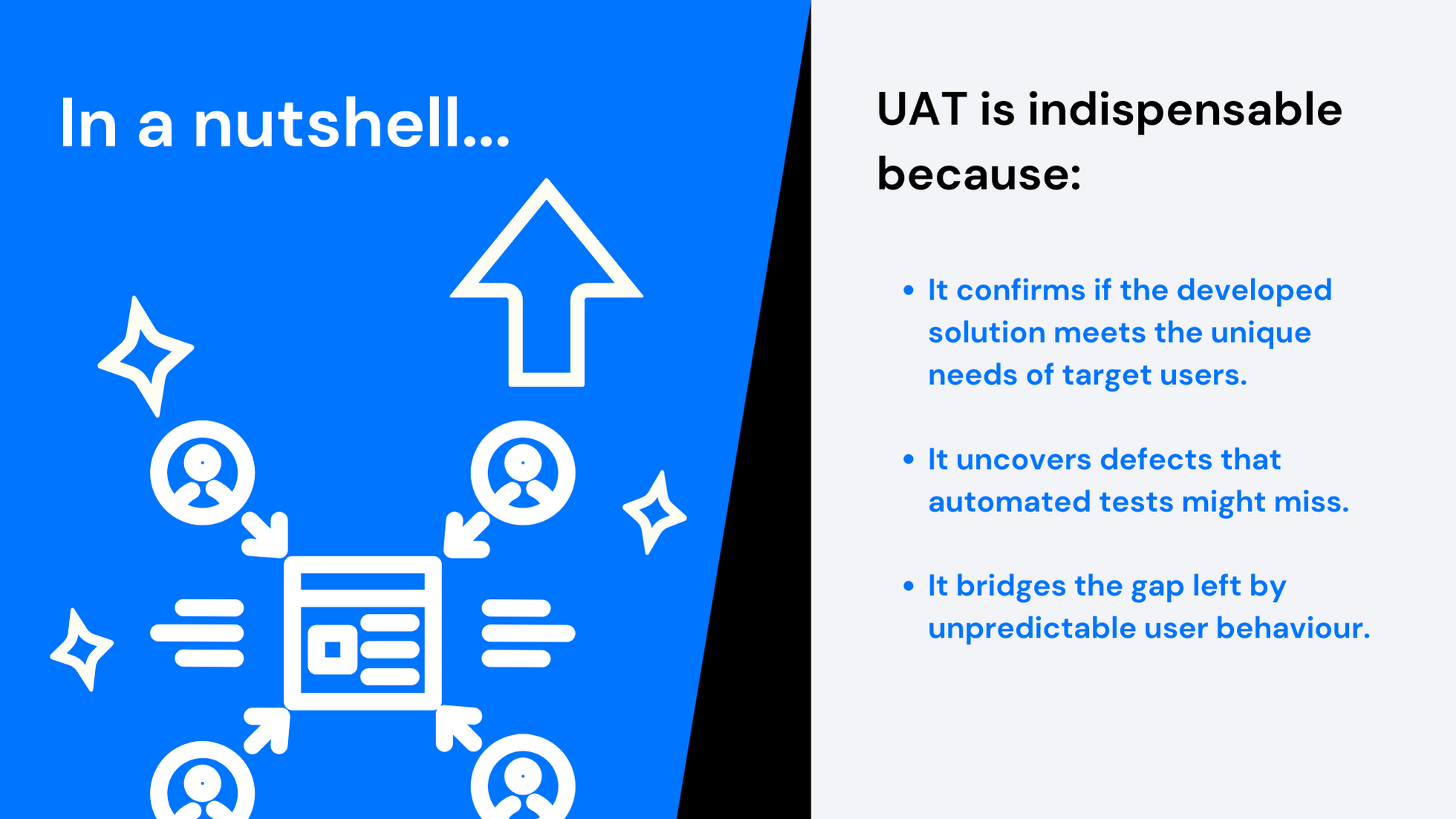Read time: 6 minutes
Welcome to the ever-evolving realm of digital and ecommerce, where innovation shapes success. Amidst the strategies and tactics, there’s a transformative practice that often takes a backseat – User Acceptance Testing (UAT). Let’s explore the profound impact of executing UAT effectively, not just on the technical front but on the overall customer experience.
What is user acceptance testing (UAT)?
User Acceptance Testing assumes a crucial role in the testing process, specifically designed to engage real users in the final stages before an ecommerce platform goes live. Unlike earlier testing phases, like unit testing, integration testing and system testing which focus on technical specifications, UAT is the final testing phase and is a targeted effort to validate the platform’s alignment with intricate business requirements in the user acceptance test environment.
In the realm of launching or maintaining an online shopping platform, UAT operates like a critical rehearsal, ensuring the performance resonates effectively with its real audience—the end users. Whether it’s a mobile app or an expansive ecommerce site, UAT quietly works behind the scenes, ensuring the platform is not only functional well-designed but also resonates with user preferences.
Positioned just before the platform’s debut or relaunch, UAT becomes a litmus test for real-world scenarios. It goes beyond evaluating software performance, delving into the subtleties of human behaviour.
The goal is to ensure that the ecommerce experience is not just technically flawless but also aligns seamlessly with user expectations and interactions. It serves as the last checkpoint where digital performance meets user experience, paving the way for conversions.
User Acceptance Testing is sometimes also known as validation testing, beta testing, application testing or end-user testing.
Unpacking UAT’s importance in ecommerce
In the world of online businesses, UAT is the linchpin that ensures success. As the ultimate quality assurance checkpoint before a product launch, UAT empowers stakeholders to validate functionality, usability, and the overall user experience. Let’s dive into why UAT is a game-changer for ecommerce platforms:
Real-world validation
Beyond the technical evaluations, UAT ensures your platform aligns seamlessly with real-world scenarios and user behaviours. It’s not just about meeting specifications; it’s about delivering an experience that users find intuitive and satisfying.
Ensuring a seamless user experience
UAT invites real users into the testing process, allowing for a thorough evaluation of the user experience. This human touch identifies potential stumbling blocks such as confusing navigation or design issues that might hinder user engagement.
Validating core functionality
Beyond appearances, UAT delves into the functionality of your ecommerce websites or apps. It serves as the detective, uncovering any functional bugs that might disrupt a smooth customer journey. It’s the insurance policy against unexpected issues, ensuring your platform aligns with real-world circumstances and exceeds user expectations.
Streamlining business operations
UAT isn’t just about your website; it’s about how it integrates into the broader digital landscape. Checking compatibility with payment gateways, inventory management systems, and order fulfilment processes ensures operational efficiency.
Amplifying conversion rates
A robust UAT process is a secret weapon for boosting conversion rates. By ironing out usability and functional issues, you create a positive customer journey, increasing the likelihood of turning browsers into satisfied buyers.
Maximising investments
While UAT demands an investment of time (typically 5-10% of the project timeline), the returns are remarkable. Uncovering and addressing potential issues during UAT can result in substantial savings compared to doing so post-launch. The cost of fixing bugs after product release is four to five times higher than addressing issues during design and development, and up to 100 times more expensive than resolving problems in the maintenance phase.
Types of UAT for a comprehensive validation
Integrating diverse testing teams and user acceptance testing approaches into your strategy becomes the cornerstone for catching potential issues and optimising user experiences. Let’s delve into these testing types, unravelling their unique contributions to creating seamless and user-friendly ecommerce platforms.
1. Exploratory testing: Uncover digital nuances
Overview: In the realm of user-centric testing, exploratory testing takes centre stage. Testers don the hat of digital explorers, moving beyond scripted scenarios to discover nuances that might elude conventional testing methods.
Role in ecommerce: This approach mimics real-world user interactions, providing insights into how users might navigate the platform organically. It’s an invaluable tool for identifying user experience subtleties that scripted tests might miss.
2. Cross-browser testing: Ensuring consistency across platforms
Overview: The diversity of web browsers necessitates a meticulous approach to ensure a consistent user experience. Cross-browser testing becomes the linchpin, guaranteeing that your platform performs seamlessly across different browsers.
Role in ecommerce: Given the varied ways users access ecommerce platforms, both on desktop and mobile devices, cross-browser testing is critical. It ensures that the user experience remains uniform, regardless of the device or browser used. Testing on one platform doesn’t automatically guarantee flawless performance on another, highlighting the importance of comprehensive cross-platform testing.
3. Usability testing: evaluating intuitiveness and user-friendliness and expected results
Overview: Usability testing is the litmus test for how intuitive and user-friendly your platform is. It assesses the ease with which users can interact with your website, providing insights and user feedback into the overall user experience.
Role in ecommerce: In the competitive ecommerce landscape, an intuitive and user-friendly interface is non-negotiable. Usability testing pinpoints areas of improvement, contributing to a positive and enjoyable shopping experience.
4. Accessibility testing: Ensuring inclusivity for diverse users
Overview: Accessibility testing evaluates how inclusive your platform is for users with diverse abilities. It ensures that features such as screen readers and keyboard navigation are seamlessly integrated.
Role in ecommerce: Inclusivity is paramount in ecommerce. Accessibility testing guarantees that your platform is accessible to users with varying abilities, expanding your reach and providing an inclusive shopping environment.
5. Localisation testing: adapting to different languages and cultures
Overview: With a global audience, localisation testing is essential. It validates that your platform functions flawlessly when adapted to different languages, cultural nuances, and regional requirements.
Role in ecommerce: For ecommerce companies with an international footprint, localisation testing is a strategic necessity. It ensures that your platform resonates with users worldwide, irrespective of language or cultural differences.
6 . Post-release testing: Proactively maintaining platform integrity
Overview: The journey doesn’t end with the initial release. Post-release testing is a proactive measure to maintain platform integrity. It ensures that updates or changes introduced post-launch do not compromise the user experience.
Role in ecommerce: Continuous improvement is key. Post-release testing safeguards against unforeseen issues, maintaining a consistent and reliable platform for users.
From uncovering nuanced user interactions to ensuring cross-browser compatibility, these methodologies contribute to creating a seamless and user-friendly environment for online shoppers.
Incorporating these testing types into your strategy is not just a best practice; it’s a strategic imperative for ecommerce companies aspiring to deliver optimal user experiences and stay ahead in the digital marketplace.
The pitfalls of developer-led UAT and the importance of a dedicated strategy & team
In the realm of ecommerce, we’ve observed a common practice of entrusting user acceptance testing either to the development team or neglecting it entirely due to time and resource constraints. Unfortunately, both approaches prove ineffective, resulting in issues on websites and apps that impact user experience and conversion rates.
While developers are integral to the development process, expecting them to conduct thorough UAT becomes impractical within the constraints of tight deadlines and substantial workloads. Their expertise lies in coding, innovating, and troubleshooting, not in providing an objective scrutiny of the end-user experience. To address this, having a separate team or individuals dedicated to UAT introduces a fresh perspective, uncovering potential problems developers might miss due to their familiarity with the code.
Acknowledging the importance of a clear UAT strategy and its proper execution transforms challenges into opportunities. This approach ensures that digital offerings not only function correctly but also stand out with excellence, ultimately enhancing user satisfaction and optimising conversion rates.
About Digivante
In the competitive world of ecommerce, Digivante emerges as a trusted partner, helping businesses deliver seamless and engaging user experiences. By leveraging a global crowd of testers and a comprehensive testing suite, Digivante empowers businesses to optimise their digital platforms and elevate their online presence. With a focus on rapid testing and comprehensive device coverage, Digivante delivers timely insights and actionable recommendations, ensuring that businesses confidently launch their platforms with exceptional user experiences.







